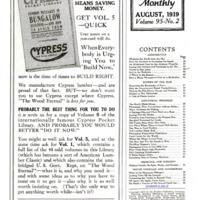The use of ultraviolet rays for secret signaling
Item
-
Title (Dublin Core)
-
The use of ultraviolet rays for secret signaling
-
Article Title and/or Image Caption (Dublin Core)
-
"Invisible" Light Signals
-
extracted text (Extract Text)
-
one of the im-
portant minor
contributions that
American genius
has given to science
during the war is
the use of ultra-violet rays for secret
signaling. The work was begun by
Irwin G. Priest and Dr. K. S. Gibson,
of the Bureau of Standards, who made
several reports on this subject to the
Navy Department. It was later
taken up by Professor Wood of Johns
Hopkins, long known as an expert in
this field, and commissioned as a
major in the Signal Corps of the Army
during the war. The Signal Corps
also obtained the assistance of the
Bureau of Standards.
To understand how it works, it is
only necessary to witness some of the
simple experiments. Take an are
lamp and put an opaque screen before
it, shutting out the light, but trans-
mitting the ultra-violet rays. Through
an ordinary telescope you see nothing.
But, by the use of a fluorescent screen
in the telescope, you find that the
ultra-violet rays from the arc lamp are
distinctly visible. You see the light
or lights behind the opaque surface.
You could follow any system of
signaling, while others, without the
specially equipped telescope, see noth-
ing. The opaque filter is transparent
to the ultra-violet rays, but blocks the
so-called white light.
‘The value of this for sccret signaling
is obvious. You could signal on the
battle-field or between ships at sea
without the enemy being aware of it.
In a naval battle a ship's wireless
might be shot away. It will now be in-
stantly possible to use this method of
secret signaling in place of the wireless.
The screen upon which the image is
formed is made up of platinum barium
cyanide or uranium sulphide.
-
Language (Dublin Core)
-
eng
-
Date Issued (Dublin Core)
-
1919-08
-
pages (Bibliographic Ontology)
-
24
-
Rights (Dublin Core)
-
Public domain (Google digitized)
-
Archived by (Dublin Core)
-
Davide Donà
-
Alberto Bordignon (Supervisor)
 Popular Science Monthly, v. 95, n. 2, 1919
Popular Science Monthly, v. 95, n. 2, 1919
 Screenshot (802).png
Screenshot (802).png
